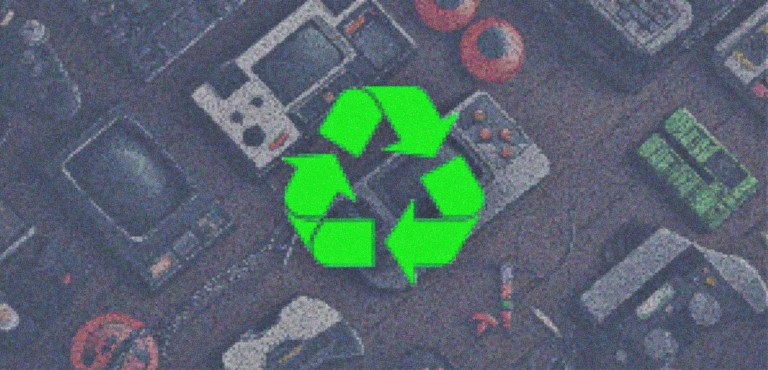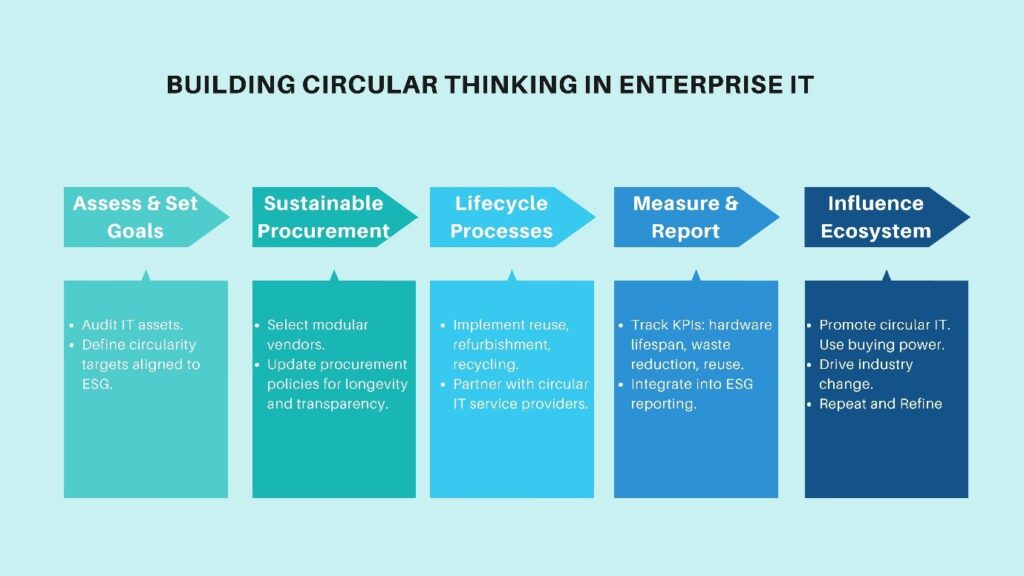
Circular Economy in IT: Smarter Hardware, Less Waste
Circular economy principles are transforming how enterprises build their IT infrastructure. In a sector long driven by fast cycles of buying and replacing, the shift towards modular hardware design and recycled materials in IT offers a path to true sustainability.
Today, many IT leaders are rethinking their strategies. They are moving away from linear models of consumption and embracing the circular economy in IT. This new mindset not only reduces waste but also lowers costs and builds resilience.
So, how exactly are these principles reshaping enterprise IT? Let’s take a closer look.
The case for circular economy in enterprise IT
The traditional “take-make-dispose” model is unsustainable. Global electronic waste is growing fast. According to the UN, we generated 62 million tonnes of e-waste in 2022 alone. Less than 20% was properly recycled.
For large businesses, this waste carries real costs. Storage, disposal, and replacement all add up. Worse, the environmental toll damages brand reputation and invites regulatory risk. That’s where the circular economy steps in. It keeps products, components, and materials in use for longer. And its designs are wasted in the system.
For enterprise IT sustainability, this means buying smarter, designing for longevity, and finding new life for old hardware.
Why modular hardware design makes sense
Modular hardware design is a key enabler of the circular model. Modular systems use standardised parts that are easy to swap or upgrade. Instead of replacing an entire server or laptop, IT teams can update one component. Need more storage? Swap in a new drive. Want faster networking? Upgrade just the network card. This approach offers many benefits:
- Cost savings: Replace parts, not entire systems.
- Flexibility: Scale hardware easily as needs grow.
- Longevity: Keep systems in service for years longer.
- Reduced e-waste: Fewer devices sent to landfills.
Vendors are responding. Companies like Dell and Framework are championing modular laptops and servers. Even hyperscale cloud players are designing data centre gear for modularity. For sustainable IT hardware solutions, modularity is fast becoming a best practice.
The power of recycled materials in IT
Recycled materials form another critical pillar of the circular economy in IT. Many modern tech products rely on raw materials such as aluminium, cobalt, lithium, and rare earth elements. But extracting these materials often comes with significant environmental and ethical costs, from habitat destruction to human rights concerns in mining regions.
By turning to recycled metals and plastics, IT manufacturers can drastically reduce the environmental impact of their products. At the same time, they create demand for more sophisticated electronic waste reduction strategies, helping to close the loop on tech waste.
The power of recycled materials in IT
Recycled materials are becoming a vital part of the circular economy in IT. Today’s tech products depend on materials like aluminium, cobalt, lithium, and rare earth elements. But extracting these resources comes with serious environmental and ethical costs, from deforestation and pollution to unsafe working conditions in mining communities.
By switching to recycled metals and plastics, IT manufacturers can significantly cut the environmental footprint of their products. At the same time, they help build stronger electronic waste reduction strategies, closing the loop and keeping valuable materials in use.
Several major brands are leading the way:
Apple has placed recycled materials at the heart of its sustainability push. Many of its devices, including the MacBook Air and Mac mini, now feature enclosures made from 100% recycled aluminium. Apple also uses recycled rare earth elements in components like the Taptic Engine, reducing the need to mine new materials. The company’s ultimate goal? To make all its products entirely from recycled or renewable materials — an ambitious target that is already setting new industry standards.
Dell has long been a pioneer in this space. Its latest Latitude laptops incorporate enclosures made from recycled plastics and reclaimed carbon fibre. Dell has also developed closed-loop recycling programmes to recover plastics from old devices, feeding them back into new products. These efforts have helped push sustainable IT hardware solutions into the corporate mainstream.
Lenovo is taking a creative approach to sustainable design. Many ThinkPad models now feature post-consumer recycled materials, and Lenovo is experimenting with bio-based polymers as well. The company also provides detailed reporting on the recycled content used in each device, giving enterprise customers the transparency they need to meet their own IT sustainability targets.
Clearly, momentum is building. More and more enterprise buyers now expect hardware vendors to show serious commitments to recycled materials in IT. And it’s not just about compliance; vendors who embrace circular sourcing are gaining an edge with customers, especially those in the public sector and sustainability-driven industries.
How Circular IT benefit businesses?
Adopting the circular economy in IT brings practical business advantages beyond just sustainability.
Cost control: Extending hardware lifecycles reduces capital expenditure. Modular upgrades cost less than full system replacements, and companies can scale hardware in line with demand.
Achieving sustainability Goals: Circular practices lower carbon emissions, reduce waste, and promote ethical sourcing, helping firms meet ESG and net-zero targets.
Compliance and risk reduction: With stricter regulations on e-waste and materials stewardship emerging globally, sustainable IT hardware solutions ensure readiness and avoid penalties.
Enhanced brand and talent appeal: Customers increasingly favour businesses with visible sustainability commitments. Circular IT also resonates with employees, particularly younger talent, fostering engagement and pride.
Building circular thinking into IT planning
To help enterprises embed circular economy principles into IT strategy, here is a practical framework to guide action:

Overcoming challenges
Of course, shifting to circular IT comes with challenges. In many regions, supply chains for refurbishment and recycling remain immature.
Enterprises may need to collaborate with partners or industry groups to develop the necessary infrastructure. Another concern is performance perception. Some IT teams worry that modular systems or devices made with recycled materials may underperform. However, modern modular designs increasingly match or exceed traditional products. Testing and education can help shift these attitudes.
Vendor lock-in is a further barrier. Proprietary systems often resist modular upgrades. To counter this, firms should favour open standards and vendors committed to circular design principles. While these hurdles exist, the broader trend is undeniable. Regulatory pressure is growing, sustainability expectations are rising, and circular models offer both environmental and economic advantages.
For enterprise IT, the shift from linear to circular is fast becoming a strategic imperative.
The future of circular tech in enterprise IT
Looking ahead, circular principles will reshape enterprise IT in profound ways. Expect more innovation in modular hardware design; think snap-in AI accelerators or plug-and-play quantum components.
Supply chains will also shift. New industries will emerge to support IT reuse, remanufacturing, and recycling. Most importantly, mindsets will evolve. IT leaders will see circularity not as a constraint, but as an enabler of innovation and resilience.
Distilled
Embracing the circular economy is now a strategic imperative for enterprise IT. It offers a smarter way to manage costs, meet sustainability goals, and build future-proof infrastructure. Modular hardware design and recycled materials in IT are key tools in this transition. Alongside strong electronic waste reduction strategies, they pave the way for a new model of enterprise IT sustainability. For IT leaders, the time to act is now. Circular tech is not just good for the planet. It’s good for business too.